Swimming to lose weight makes a lot of sense for several reasons.
However, there are a few pitfalls to be aware of so that you can use swimming as an effective weight control exercise.
Swimming is an excellent aerobic exercise that works out the whole body and has a low impact on joints.

However, swimming to lose weight is a somewhat controversial subject.
I believe that it works well as long as a few basic principles are observed.
Aerobic Workout Zone
Swimming is often said to be an aerobic exercise.
However, for an aerobic exercise to be effective at burning fat, it should be practiced between 60 – 80 % of the maximum heart rate.
If the heart rate is below this range, the exercise isn’t demanding enough and won’t burn a lot of calories.
And if the heart rate is above this range, the exercise becomes anaerobic, which means carbohydrates are burned, not fat, and the exercise can’t be sustained for a long time.
A standard formula to calculate the maximum heart rate is to subtract your age from 220. For example, if your age is 37 years, your maximum heart rate will be 220 – 37 = 183 beats per minute.
And your target heart rate range should be between 60 and 80 % of 183 BPM which is between 110 and 146 BPM.
So when you start out with swimming, is a good idea to wear a heart rate monitor so you can make sure you are swimming with the correct level of intensity.
For example, Polar makes excellent waterproof heart rate monitors.
Exercise Duration
When you are doing an aerobic workout, the fat burning becomes only effective after about twenty minutes of continuous exercise.
This is because the body has to burn the carbohydrates reserves first before switching to fat.
So make sure that you observe the right amount of duration in addition to a correct target heart rate.
The ideal is a few swim sessions per week of at least 30 minutes.
If you are starting out, it is unlikely you will be able to swim for 30 minutes right off the bat.
This isn’t a problem as long as you keep going to the pool regularly.
Your endurance and technique will improve over time, and you should be able to sustain 30 minutes of continuous swimming after a few weeks.
Swimming Technique
As suggested in the previous paragraph, the technique is important in swimming.
With poor technique, you risk becoming quickly exhausted or to workout in the wrong heart rate range.
Another problem with poor swimming technique is that you can quickly become bored and frustrated as your options are limited.
However, if you also work on improving your swimming technique, learn new swimming strokes and try out new exercises, you have a lot more fun while swimming!
So when you take up swimming, make sure to also work on improving your technique, either with the help of the information available on this website, books, DVDs, swimming lessons at your local pool, etc.
Diet and Eating Habits
Several studies show that swimming helps weight control and several others show that swimming doesn’t help.
A recurring theme seems, however, to be that swimmers are often hungry after a workout, more often than runners for example, and especially if the swim workout has been in cold water.
That could explain the conflicting results in those studies about swimming to lose weight because it could be that swimmers overeat more after a workout to recover lost calories than athletes in other sports.
So to lose weight make sure you watch your eating habits and especially do so after a difficult workout :-).
I have additional tips in the article Swimming Workouts and Nutrition Tips for Overweight People.
Conclusion
I believe that swimming to lose weight works as long as the principles described earlier are observed.
I’ve been able to maintain my ideal weight of about 77kg (170lbs) for a height of 1,79m (5’10”) for years, and I think my three weekly swim sessions combined with healthy eating habits are in large parts responsible for it.
